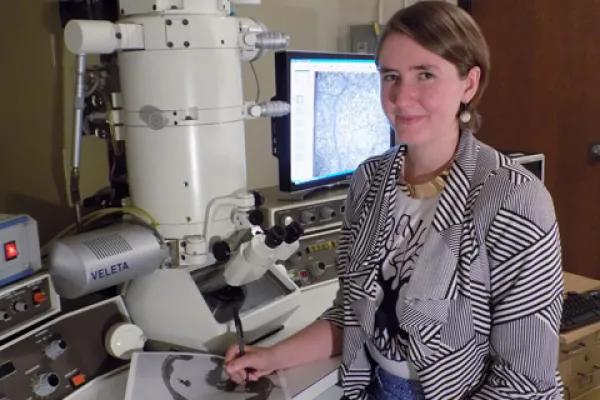Seeing the Art in Science: Anja Nordstrom ’18’s Zebrafish Portfolio
Research & Inquiry

Published August 2, 2017
Is it possible to find artistic inspiration under a microscope?
For Anja Nordstrom ’18 the answer is a resounding “yes!”
Nordstrom, a participant in Smith’s Summer Research Fellowship (SURF) program, has spent much of the summer looking at small sections of zebrafish brains under a cutting-edge microscope in Smith’s Center for Microscopy and Imaging. Now, she’s creating a portfolio of illustrations based on those microscopic views to assist researchers in associate professor Michael Barresi’s zebrafish lab.
Images that students have captured via fluorescent microscopy show green and red areas in zebrafish embryo brains where the cells appear to be interacting, Nordstrom says. She hopes her illustrations—which will also make use of other microscopy techniques—will help increase scientific understanding of how neural connections are made in developing zebrafish.
Nordstrom, a neuroscience major with a minor in studio art, says her project reflects advances in microscopy that have improved visual understanding of cell biology.
“There’s a lot more art in science now because of new technology,” she says, citing medical imaging as a prime example. “The goal with scientific illustrations is to communicate in a visual way and get people interested in a complex process. You’re making science accessible through images and art.”
That’s an interest Nordstrom shares with her project adviser, Judith Wopereis, technical director of Smith’s Center for Microscopy.
“I like the visual aspect of this project,” says Wopereis, who has trained Nordstrom in microscopy techniques needed to produce her portfolio. “Anja’s a special case because she is combining art and science. It’s a nice combination.”
Nordstrom is one of 144 students participating this year in the SURF program on campus. Since it was established 50 years ago, SURF has provided some 3,500 Smithies with immersive research experiences with staff and faculty mentors.
Studies show the SURF program has had lasting impact: program participants are more likely than their peers to engage in advanced research in their junior and senior years at Smith, as well as after graduation.
Nordstrom says she applied to SURF because it offered concentrated time in the lab.
“I’m always amazed by people who are able to research on the side” during the semester, she says. “For me, it’s great to have the time to be able to work on a project like this. It feels more like a job.”
Nordstrom says her SURF project has helped her learn valuable visual techniques—and also expanded her knowledge of biological research.
“Seeing things at this magnitude—looking at cells—has shown me how researchers start to figure things out,” she says.
Barresi, whose lab has been a magnet for SURF students over the years, says Nordstrom’s illustrations will help researchers better visualize cell interactions in developing zebrafish nervous systems.
“People can certainly see art in science, and see science in the construction of art,” he says. “But it’s a novel occurrence when the two perspectives are aptly applied to arrive at a common solution.”
Nordstrom—who attended the annual meeting of the Association of Medical Illustrators in Austin, Texas, last month—plans to continue work on her zebrafish portfolio next semester as a special studies course.
She says her SURF experience has shown her more about the links between art and science.
“I think the approaches are actually very similar,” Nordstrom says. “You go through all of this trial and error, and then you arrive at an answer—or you fail. You also have to be creative because you’re doing something that’s never been done before.”